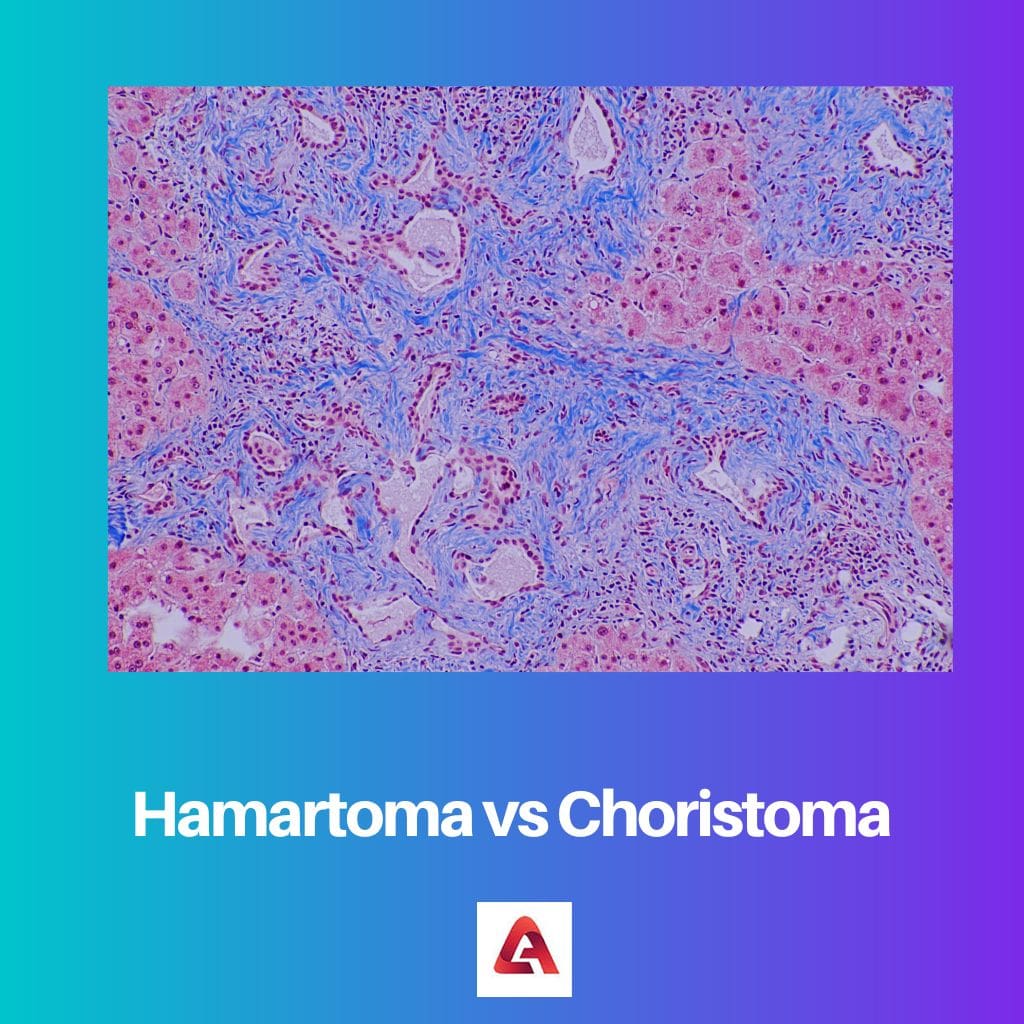Hamartoma and Choristoma are two types of abnormal growths or tumors that can occur in the body. While they may have similarities, there are also distinct differences between them.
A Hamartoma is an abnormal accumulation or collection of cells within a tissue, resulting in a lump or mass on the body. The cells in a Hamartoma are normal, but they are arranged and organized abnormally due to abnormal growth of tissue. They may contain various cells that do not form together, such as fat, muscle, and nerves.
A Choristoma is an abnormal mass that contains tissues or organs from other body parts. The cells of a Choristoma are normal, but the tissue is from a different area of the body than where the tumor originated. For example, it may contain brain tissue in an area of the skin or bone marrow in an area of the liver.
A hamartoma is a benign tumor-like growth made up of normal tissues that develop in the wrong place. A choristoma is a benign growth made up of normal tissues that are not normally found in the area where they are located. The key difference between the two is the location of the growth.
Key Takeaways
- Hamartomas are benign, disorganized growths of normal tissue found in the correct location.
- Choristomas are benign growths of normal tissue but are found in an abnormal location.
- Hamartomas grow with the surrounding tissue, whereas choristomas don’t change with the surrounding tissue.

Comparison Table
| Parameters of Comparison | Hamartoma | Choristoma |
|---|---|---|
| Meaning | Growth of abnormal tissue in some areas of the body. | Growth of normal tissue in the wrong part of the body |
| Symptoms | Depending on where it is found, it could be chest pain if found in the heart or coughing if found in the lungs. | Depending on the organ where it is found, it could be loss of vision or hearing. |
| Causes | Gene mutations include changes in the PTEN gene, Peutz-jeghers syndrome, Cowden syndrome, and embryological errors. | Developmental errors and genetic mutations such as that of the CTNNB1 gene. |
| Diagnosis | Imaging methods such as MRI, CT, and X-rays. | Imaging methods such as MRI or CT and biopsy for the identification of cells under the microscope |
| Cell type | Disorganized and not normal cells. | Mature and normal recognizable cells. |
| Treatment | Gamma knife radiation surgery of conventional surgery | Surgery or sometimes chemotherapy |
What is Hamartoma?
Hamartoma is a rare tumor that may form in the body, occurring in infants and small children. It can affect any body part but most commonly appears on the skin, eyes, brain, or gastrointestinal tract. A hamartoma is made up of tissue that looks like normal body tissue but has grown abnormally. It is not cancerous or malignant, but it can cause various health problems depending on where it is located in the body.
Symptoms of a hamartoma vary depending on its location and size. A skin hamartoma may appear as a raised growth that can range in color from pink to brownish-black. It may also be painful when touched. An eye hamartoma, or ocular Hamartoma, may cause blurred vision and other visual disturbances. A hamartoma in the brain can cause delayed development, seizure activity, headaches, and changes in behavior. Gastrointestinal tract hamartomas can cause digestive symptoms such as pain, nausea, vomiting, and constipation.
In most cases, hamartomas can be treated with either surgical removal or radiation therapy. If the Hamartoma is small and not causing any significant health problems, it may be monitored without treatment. However, further treatment is likely necessary if the growth is large or causes discomfort. For those seeking an alternative approach, some natural remedies can help manage hamartoma symptoms. These include changes in diet and lifestyle and herbal supplements that may reduce inflammation and improve overall health.

What is Choristoma?
Choristoma is an abnormal structure or tissue that forms in the wrong place or at the wrong time during the development of an animal or human body. It is an embryological abnormality where a non-ectodermal tissue is formed outside its normal location. It can occur in any organ but most commonly occurs in the mouth, nose, and throat. Choristomas are benign (non-cancerous) and do not spread to other body parts. They may be caused by a genetic defect or an environmental factor, such as radiation exposure. Treatment involves removing the abnormal tissue surgically.
In some cases, biopsies may be necessary to confirm the diagnosis of Choristoma. It is important to note that Choristomas may sometimes recur even after successful removal. Additional treatments such as radiation therapy or chemotherapy may be necessary in these cases.
Choristomas can cause a variety of symptoms depending on their size and location. Common symptoms include difficulty breathing, voice changes, persistent cough, pain in the affected area, bleeding from the nose or throat, and even facial deformities. If left untreated, Choristomas can lead to more serious complications such as infection or airway obstruction.
Main Differences Between Hamartoma and Choristoma
- Hamartoma is an abnormal proliferation of cells normally found in the affected tissue, while Choristoma is a benign tumor composed of mature, normal cells in an abnormal location.
- In hamartomas, the tissues do not have their usual arrangement or structure and may be made up of several different kinds
- of tissue, whereas in Choristomas, the tissue arrangement is normal for that location.
- Hamartomas may be hereditary or acquired and can occur anywhere in the body, but Choristomas are always congenital and occur only in specific locations.
- Hamartomas tend to grow slowly, if at all, whereas choristomas can remain stationary or undergo rapid growth.
- Hamartomas are diagnosed, while Choristomas are asymptomatic.
- https://www.sciencedirect.com/science/article/pii/S002252231934735X
- https://jamanetwork.com/journals/jamadermatology/article-abstract/532904
